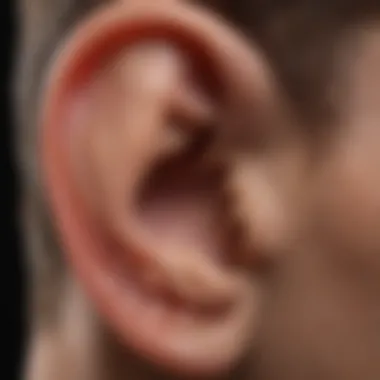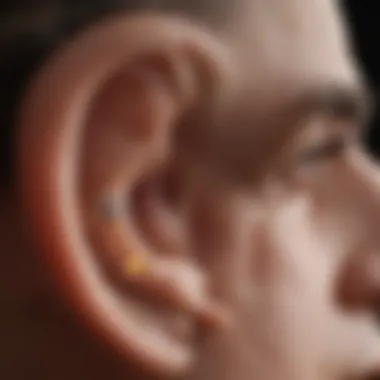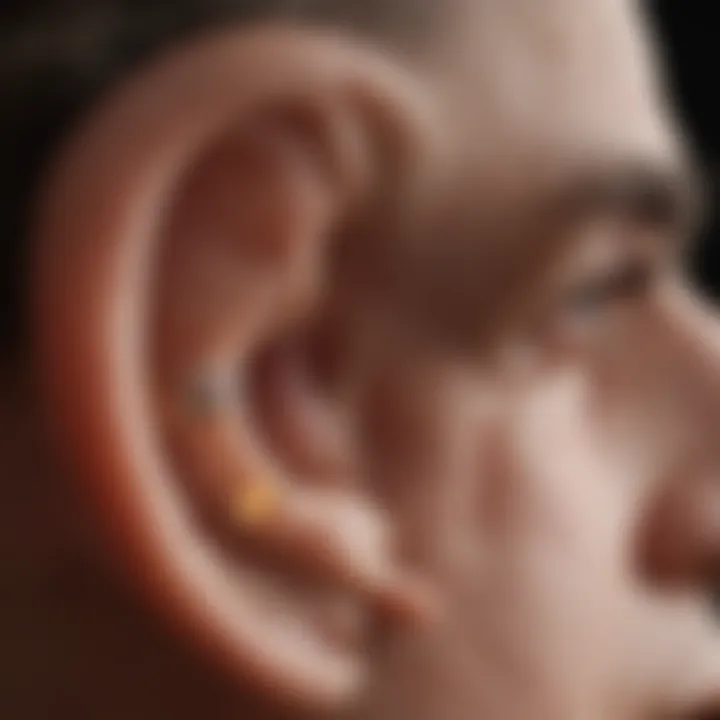Understanding Ear Frequency and Its Implications


Intro
Ear frequency is a term that, while often overlooked in everyday conversation, plays a vital role in how we process sound. The human ear is a remarkable organ, tuned to pick up a wide range of frequencies, from the low rumble of a bass guitar to the high-pitched chirp of a birdsong. The science behind hearing is complex and fascinating, extending into fields such as audiology, sound therapy, and even behavioral research. This article seeks to unpack these layers and provide an in-depth look into ear frequency, its implications, and its applications in various domains.
The nuances of ear frequency stretch beyond mere acoustics. It isn't just about what we hear; it’s about how these auditory inputs affect our emotions, behaviors, and overall well-being. For students, educators, and researchers, understanding these concepts can unlock insights into areas ranging from communication to therapy. As we delve deeper, we'll examine how sound waves interact with the physiological and neurological aspects of hearing, culminating in a comprehensive guide that sheds light on the significance of frequency in our lives.
Prelims to Ear Frequency
The exploration of ear frequency serves as a fundamental cornerstone in comprehending auditory perception and its significant imprints on our everyday lives. This topic provides a framework for understanding how humans interact with sound, embracing everything from the simple joy of music to the complexities of language processing. To break it down, ear frequency refers to the measurement of sound waves, specifically the number of vibrational cycles per second, and is pivotal in determining how we perceive different pitches.
In this section, we will grapple with various implications associated with ear frequency, specifically its role in audiology, mental health, and communication. An understanding of ear frequency not only assists professionals in diagnosing auditory conditions but also offers insights into therapeutic practices, enhancing overall well-being through sound awareness. Considering the intricate relationship between frequency and human experience, grasping the basics of how we hear lays the groundwork for further discussions throughout this article.
Definition of Ear Frequency
Ear frequency can be succinctly defined as the rate at which sound waves oscillate, measured in Hertz (Hz). A sound wave oscillates as it travels, and the frequency denotes how many times this oscillation occurs within one second. For instance, a sound wave with a frequency of 440 Hz vibrates 440 times in a second and is commonly recognized as the musical note A above middle C.
The broader spectrum of human hearing allows us to perceive frequencies ranging from approximately 20 Hz to 20,000 Hz, or 20 kHz, although this range can diminish with age or certain auditory conditions. Essentially, frequencies below 20 Hz are termed infrasound, while those exceeding 20 kHz are categorized as ultrasound. These classifications underline the importance of ear frequency beyond mere perception, extending into fields such as sonic therapy and wildlife communication.
Historical Context
The journey into the understanding of ear frequency traces back centuries, with early studies dating as far as the 17th century. Pioneers like Galileo Galilei and Christiaan Huygens began delving into the principles of sound and vibrations, laying the groundwork for future research.
As we ventured into the 19th century, scientists such as Hermann von Helmholtz contributed significantly to the understanding of how human ears interpret different frequencies. Helmholtz's work led to the invention of the resonator, which allowed the study of sound frequencies in detail. With the advent of modern technology, particularly during the 20th century, the exploration of ear frequency advanced rapidly. The development of audiometers introduced standardized methods for assessing hearing capabilities, shifting from mere curiosity to practical applications in health and communication.
In summary, the historical trajectory of ear frequency highlights not just an area of scientific exploration, but also a journey that interweaves human interaction with sound across cultures and disciplines. This understanding sets the stage for further inquiries into the physiological, psychological, and practical implications of ear frequency.
Physiology of Hearing
Understanding the physiology of hearing is crucial to comprehending how ear frequency impacts auditory perception. Hearing is not merely a passive act but involves intricate processes that translate sound waves into neural signals. By dissecting the mechanisms behind hearing, we can unearth the implications of frequency on our daily interactions, communication, and overall health.
Structure of the Ear
Outer Ear
The outer ear serves as the gateway to auditory perception. Its main role is to gather sound waves from the environment and funnel them into the ear canal. A distinguishing feature of the outer ear is the pinna, which is the visible part that helps in localizing sounds. This sort of shape can catch sound waves from different directions, which adds precision to how we perceive sounds in our surroundings. One advantage of the outer ear is its ability to amplify certain frequencies, making it a vital component in enhancing our hearing capabilities.
However, this structure is not without flaws. The outer ear can be susceptible to environmental factors, such as wind and noise interference, which can distract or diminish the clarity of the sound being captured.
Middle Ear
Moving inward, the middle ear functions as a sound amplifier. It contains three small bones, known as the ossicles—malleus, incus, and stapes. The key characteristic of the middle ear is its ability to transform sound vibrations into more powerful waves, which is essential for effective sound transmission to the inner ear. This amplification is particularly beneficial for understanding speech and environmental sounds, especially in crowded or noisy settings.
Nonetheless, the middle ear can be vulnerable to infections and fluid buildup, which can severely affect hearing. Conditions such as otitis media can lead to significant hearing loss if not properly managed, emphasizing the necessity of a healthy middle ear for effective auditory function.
Inner Ear
The inner ear is where the magic truly happens. It houses the cochlea, a spiral-shaped organ responsible for translating sound vibrations into electrical signals. A unique feature of the inner ear is its exquisite arrangement of hair cells that respond to specific frequencies. This specificity makes the inner ear crucial for distinguishing between different pitches, allowing humans to appreciate music and detect speech nuances.
The inner ear's downside, however, is its vulnerability to noise exposure and age-related damage, which can result in presbycusis—a common form of age-related hearing loss. Protecting the inner ear is essential, as its proper functioning is paramount for a comprehensive listening experience.


The Auditory Pathway
Hearing Mechanism
The hearing mechanism refers to the entire process that starts when sound waves enter the outer ear and concludes with the brain interpreting these signals. The hearing mechanism's key characteristic is its precise sequential functionality—each part of the ear plays a defined role to ensure sound is transformed and transmitted correctly. Understanding this mechanism offers insights into various auditory disorders and helps devise better hearing aids and therapies.
Despite its efficiency, the hearing mechanism can be disrupted by factors such as injury or disease, leading to hearing impairment. Knowing how these disruptions occur can guide effective management strategies.
Neuronal Pathways
Neuronal pathways are the final stretch of auditory processing. Once sound waves turn into electrical impulses thanks to the inner ear, these signals travel via the auditory nerve to the brain. One of the crucial aspects of these pathways is their ability to process complex auditory information, such as differentiating between speech and background noise.
However, disruptions in neuronal pathways can lead to auditory processing disorders, making it challenging for individuals to make sense of sounds. Addressing these issues can significantly enhance communication skills and overall quality of life for affected individuals.
Frequency and Pitch
Understanding frequency and pitch is crucial for deciphering how humans experience and interpret sound. Frequency, usually measured in Hertz (Hz), defines the number of oscillations per second of a sound wave, while pitch refers to how high or low a sound appears to be in our perception. Both elements play a vital role in communication, music, and our overall interaction with sound. Without a grasp of these concepts, it would be very tricky to appreciate the nuances of various sounds—from the chirping of a bird to a dramatic crescendo in a symphony.
Understanding Frequency
Measurement Units: Hertz
Hertz, abbreviated as Hz, is the unit used to measure frequency. Its simplicity is one of its defining traits; one Hz equals one cycle per second. This straightforward measurement makes it a preferred choice when discussing sound. For most people, it boils down to the fact that a higher Hz typically correlates with a higher perceived pitch, making it crucial for various applications, from designing auditory equipment to diagnosing hearing impairments in audiology.
A unique feature of Hertz is that it provides an objective standard. This means researchers can universally communicate findings, making it an incredibly beneficial tool in scientific discourse. However, it can be somewhat limiting. Not everyone understands the implications of different Hz readings; while a musician might grasp that 440 Hz represents the "A" note above middle C, a layperson may not have that depth of understanding. Thus, although wildly useful, Hertz does have its quirks.
Frequency Range in Humans
The human frequency range typically spans from about 20 Hz to 20,000 Hz, though this can vary with age and exposure to sound. Knowing this range is vital for understanding auditory perception; after all, if a sound falls outside this spectrum, we simply cannot hear it. This range not only allows us to appreciate music but also to communicate effectively.
A key characteristic of this range is its narrowness compared to the vast spectrum of sounds present in the environment. Discussing this range opens avenues for conversations about audiology, especially concerning hearing loss. As individuals age, their ability to perceive higher frequencies tends to diminish. This leads to a unique opportunity for audiologists to develop tailored sound therapies that cater to the specific needs of the aging population. The limitations in frequency perception can pose challenges, but they also open doors for innovations in sound therapy.
Pitch Perception
Relation Between Frequency and Pitch
The connection between frequency and pitch is foundational to our understanding of sound. Essentially, a sound's frequency determines its pitch; a higher frequency is perceived as a higher pitch. This relationship is crucial in music theory and auditory science. For example, when teaching music, instructors often emphasize the importance of interval relationships, which hinge on frequencies.
This relationship's key characteristic is its consistency. It's fairly uniform across different types of sounds; thus, it serves as a reliable metric for both musicians and scientists alike. Understanding this can aid researchers in fields like psychoacoustics, where studying how humans perceive sound relates closely to frequency and pitch.
However, one specific challenge lies in the variations in human perception. Two people may hear the same frequency yet interpret it differently due to various factors, such as their personal experience or hearing capabilities. This disparity makes the relationship both fascinating and complex.
Factors Influencing Pitch Perception
Several factors can influence how pitch is perceived, going beyond mere frequency. These encompass the listener's age, cultural background, and even the context in which the sound is encountered. For instance, a younger person may find higher pitches easier to discern than an older adult who might struggle with the same sounds.
Moreover, the context can play a pivotal role. Sounds in nature may be perceived differently than those in controlled environments, like music halls. The unique interplay of all these elements serves as a reminder that pitch is not solely about frequency; it involves cognitive and emotional layers that affect how we experience sound.
These varying factors highlight why understanding pitch perception is essential across various disciplines. Whether it's designing instruments that cater to different age groups or developing therapies for individuals with hearing impairments, awareness of how pitch can be influenced provides valuable insights for researchers, educators, and healthcare professionals alike.


"Understanding frequency and pitch is not just about sound; it's about comprehending communication, emotion, and the very essence of our auditory experiences."
In summary, frequency and pitch serve as pivotal cornerstones in our exploration of sound. They intertwine to form a rich tapestry that influences everything from music composition to hearing loss treatment, underscoring the profound implications associated with our understanding of ear frequency.
Psychological and Behavioral Impact
Understanding the psychological and behavioral impact of sound frequency is essential. This section explores how variations in sound frequencies can influence emotions, cognitive functions, and overall mental well-being. The exploration helps connect the dots between auditory experiences and human reactions, shedding light on the relevance of ear frequency in daily life.
Influence of Sound Frequency on Emotions
Humans are inherently emotional beings, and sound plays a significant role in shaping feelings. Frequencies act like a hidden thread, linking melodies to moods. For example, a soft piano tune can stir feelings of nostalgia, while a fast-paced beat might ramp up excitement or anxiety. This phenomenon isn't just anecdotal; scientific studies have shown that specific frequency ranges can evoke particular emotional responses.
Research indicates that low frequencies, such as those around 40 Hertz, are often associated with feelings of calmness and safety. On the flip side, higher frequencies tend to induce alertness or even stress. In therapy settings, sound frequencies are harnessed purposefully. For instance, techniques like binaural beats, which present slightly different frequencies to each ear, aim to promote relaxation or concentration by altering brain wave patterns.
Applications of Ear Frequency Knowledge
Understanding ear frequency is not just an academic exercise; it has tangible applications that shape our daily lives and well-being. Knowledge about ear frequency plays a pivotal role in various fields, influencing technologies, therapeutic practices, and clinical assessments. This section aims to connect the dots between frequency understanding and its multiple real-world implications.
Audiology and Hearing Tests
Hearing Loss Diagnosis
Diagnosing hearing loss hinges on the precise measurement of ear frequency responses. Audiologists utilize equipment that emits sounds at various frequencies to determine an individual's hearing capacity. The key characteristic of this diagnostic method is its ability to pinpoint exactly how well a person can perceive different sound frequencies. This aspect makes hearing loss diagnosis a popular choice in audiology, as it establishes a solid baseline for any hearing impairments.
Furthermore, hearing loss diagnosis is unique in that it can reveal specific frequency ranges where the hearing loss occurs. This detailed insight allows clinicians to tailor rehabilitation or amplification strategies accordingly. However, one downside is that not every test is suitable for every age group, particularly young children, which necessitates specialized testing equipment.
Tinnitus Management
Tinnitus management is another significant application of ear frequency expertise. Tinnitus often manifests as a perception of noise or ringing in the ears, typically in the higher frequency range. The treatment approaches often focus on sound therapy, which employs specific frequencies known to mask or reduce the perception of tinnitus.
The striking feature of tinnitus management is its adaptability; many individuals respond well to white noise or customized sound frequencies designed to divert attention away from the ringing. This versatility makes it a beneficial choice in managing this elusive condition. Nevertheless, its effect can vary from person to person, and some may find it challenging to identify the right frequency that brings relief.
Sound Therapy and Frequencies
Meditation and Relaxation
Meditation and relaxation techniques often incorporate specific frequencies to enhance tranquility and promote mental clarity. The practice of using sound waves during meditation can significantly aid in achieving a calming mental state. Frequencies that resonate in the lower range are generally favored for their ability to slow down heart rates and ease muscle tension. This characteristic renders meditation and relaxation practices not only popular but deeply effective in stress management.
One unique feature here is the concept of binaural beats, where two different frequencies are played in each ear, leading to a perceivable third sound that can induce meditative states. While many appreciate this method for its simplicity, it may not resonate with everyone. Some individuals find it difficult to concentrate on the beats, hindering the intended meditative effect.
Frequency-Based Healing Techniques
Frequency-based healing techniques encompass a variety of practices such as sound baths and vibrational therapies aimed at healing through sound. The premise is simple: different frequencies can influence body energy, leading to physical and mental healing. One key characteristic is the personalized nature of these treatments; practitioners often select frequencies based on an individual's specific needs and ailments, making it a tailored approach to wellness.
However, a distinct challenge lies in the scientific validation of these techniques, as much of the evidence remains anecdotal. While many people report benefits from sound therapy, critics argue that more rigorous scientific studies are needed to substantiate claims of effectiveness. This duality raises questions about the future trajectories of sound therapy as a legitimate healing method versus a wellness trend.
Recent Research and Findings
Recent investigations into ear frequency have revealed several fascinating insights that can shape our understanding of auditory perception. This section aims to highlight why staying abreast of such research is vital. Insights from these studies not only equip professionals in the fields of audiology and acoustics but also inform therapists using sound frequency for healing. Advances in research can dictate the methods and equipment used in clinical settings.


Cutting-Edge Studies on Frequency Perception
Recent studies have produced eye-opening findings regarding how individuals perceive different frequencies. Researchers have begun exploring how the brain decodes and categorizes sound frequencies across various environments, examining variables such as age, hearing impairment, and even cultural background. A particularly interesting study observed that younger people tend to perceive higher frequencies better than older individuals, attributing this differential largely to the biological aging process of the ear and the auditory cortex.
Some experiments have employed advanced imaging techniques to view the brain’s response to sound frequencies. For example, using fMRI technology, scientists have documented distinct patterns of brain activity when subjects are exposed to varying frequencies. These findings suggest that our brains may no longer just register frequency information but rather interpret and react to it in uniquely personal ways.
Moreover, research focusing on frequency perception has started to tap into psychological dimensions. It has been demonstrated that specific frequency ranges can evoke emotional responses. You might have experienced this effect; sound frequencies of around 528 Hz, for instance, are often linked with feelings of relaxation and restoration. Thus, a broader understanding of frequency perception can deepen insights into how we emotionally respond to different sound environments.
Advancements in Sound Engineering
Sound engineering represents another field significantly influenced by the insights derived from recent research into ear frequency. Engineers are actively integrating findings from auditory perception studies to innovate and improve sound systems. For instance, with a better understanding of frequency masking—where certain sounds may interfere with the perception of others—engineers can design more effective speakers and headphones that accurately reproduce intended sounds.
Additionally, in the realm of noise-canceling technology, advancements allow devices to analyze incoming sound waves in real-time and create counteracting waves to produce silence. Recent developments in algorithms have improved this technology, ensuring higher efficiency in minimizing disruptive frequencies.
These engineering feats have broad applications. In urban design, for example, environments can be optimized not just for aesthetic appeal but also for auditory comfort. Contextual noise—like traffic—can be mitigated by strategically designed structures that reflect and absorb certain frequencies, enhancing overall urban livability.
"Understanding how we perceive sound shapes the future of both therapeutic practices and sound technology."
This intersection of research and technology is not just a niche topic anymore; it is becoming increasingly critical in various aspects of modern life, from healthcare to entertainment. Such studies inspire us to rethink how we engage with sound and push the boundaries of what is possible.
The Future of Ear Frequency Studies
The exploration of ear frequency is not just a scientific journey but a constantly evolving narrative that looks to the horizon. Understanding how we hear and process sound has critical implications in neurology, psychology, audiology, and technology. With advancements piling up like books in a library, one can see a mosaic forming that illustrates the growing importance of ear frequency studies in various fields. The ongoing research and emerging technologies are set to redefine how we experience sound—shaping therapies, improving ergonomic devices, and enhancing auditory experiences in everyday life.
Emerging Technologies in Auditory Research
New technologies are reshaping the landscape of auditory research. For instance, virtual and augmented reality are pushing the envelope on how we perceive sound in immersive environments. These technologic platforms not only create a space for interaction but also allow researchers to manipulate sound frequency in real-time. Consider the potential implications of this—designers can create simulations to study how different sound frequencies impact emotional responses or cognitive functions. Additionally, wearable technology such as hearing aids or sound-enhancing devices are getting smarter, often employing machine learning algorithms to customize auditory experiences based on the unique preferences of users.
Such advancements highlight a significant shift towards personalized soundscapes, focusing on individual needs and experiences.
Potential Areas for Exploration
The scope of future ear frequency studies remains expansive, and here are some routes that researchers could traverse:
Interdisciplinary Approaches
The advent of interdisciplinary approaches in science encourages collaboration between diverse fields. This is particularly vital in ear frequency studies as it brings together audiologists, neurologists, and psychologists for tackling complex problems. The key characteristic of such an approach lies in its collaborative nature, which emphasizes the exchange of ideas and methods. By pooling expertise from varied disciplines, researchers can shed new light on the multifaceted impact of sound frequencies on human health and cognition.
The unique feature of interdisciplinary exploration is its ability to create a holistic view. This broad perspective facilitates nuanced findings that a single discipline might overlook. However, balancing research priorities from different fields can be challenging, often requiring extensive communication and understanding. Still, the benefits far outweigh the drawbacks, fueling innovation and deepening insights into sound perception and its implications for human behavior.
Long-Term Health Implications
Long-term health implications of ear frequency studies are an emerging focus of interest. Public health research increasingly looks at how prolonged exposure to specific frequencies—be it soothing or disruptive—can affect mental and physical well-being. The key aspect here is its proactive nature, anticipating potential health consequences before they manifest significantly. This preventative approach can lead to more informed strategies for mitigating the adverse effects of noise pollution or improving therapeutic sound applications.
One notable feature of this research direction is its preventative lens, providing insights that can help in crafting policies aimed at reducing health risks associated with auditory environments. Evaluating how frequency variation impacts stress levels, sleep quality, and cognitive performance opens windows of opportunity for implementing sound therapy in clinical settings. Yet, as with all research, balancing ethical considerations and practicability can sometimes limit exploration. Nevertheless, the potential solutions that can arise from long-term studies are exciting, signaling a future where ear frequency knowledge can contribute meaningfully to public health norms and practices.
"The future unfolds layers of possibility in the realm of auditory studies, prompting us to challenge existing paradigms and embrace a sound-centric approach to health and science."
Finale
In wrapping up our exploration of ear frequency, it's crucial to reflect on the multifaceted implications discussed throughout the article. Understanding ear frequency is not just an academic exercise; it holds vast significance in various domains ranging from audiology to sound therapy and beyond. This article reveals how ear frequency impacts not only our auditory perception but also our emotions and cognitive functions. By grasping the nuances of how frequency operates, we can better appreciate its role in enhancing communication and overall well-being.
Summary of Key Points
- Definition and Importance: Ear frequency refers to the perception of different sound frequencies by the human ear, influencing how we process and interpret sounds in our environment.
- Physiological Backbone: The structure of the inner ear plays a vital role in frequency detection, where hair cells respond to specific frequencies, transforming sound vibrations into neural signals.
- Psychological Effects: Frequencies can evoke emotions and alter behavioral responses. Understanding these nuances can inform therapeutic practices.
- Applications in Science: This knowledge is fundamental in fields like audiology, sound engineering, and even cognitive psychology, leading to advanced diagnostic tools and treatment methods.
- Forward-Looking Perspectives: Emerging technologies and interdisciplinary approaches to ear frequency studies promise to enhance our understanding of auditory experiences and their health implications.
Final Thoughts
As we conclude, it’s essential to highlight that the study of ear frequency is continually evolving. As new research emerges and technologies advance, we gain sharper insights into how frequency shapes our daily experiences. In our increasingly noisy world, the quest for understanding sound and its effects becomes even more crucial. For students, researchers, educators, and professionals alike, staying abreast of these developments can foster more impactful applications of auditory research. The implications of ear frequency extend deeply into many aspects of life, from mental health to communication strategies. Ultimately, a deeper understanding of ear frequency can empower individuals and communities, creating healthier and more tuned-in environments.



